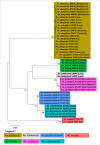MALDI-TOF MS: An effective tool for a global surveillance of dengue vector species
- PMID: 36264911
- PMCID: PMC9584457
- DOI: 10.1371/journal.pone.0276488
MALDI-TOF MS: An effective tool for a global surveillance of dengue vector species
Abstract
Dengue, Zika and chikungunya viruses cause significant human public health burdens in the world. These arboviruses are transmitted by vector mosquito species notably Aedes aegypti and Aedes albopictus. In the Pacific region, more vector species of arboviruses belonging to the Scutellaris Group are present. Due to the expansion of human travel and international trade, the threat of their dispersal in other world regions is on the rise. Strengthening of entomological surveillance ensuring rapid detection of introduced vector species is therefore required in order to avoid their establishment and the risk of arbovirus outbreaks. This surveillance relies on accurate species identification. The aim of this study was to assess the use of the Matrix-Assisted Laser Desorption Ionization Time-Of-Flight Mass Spectrometry (MALDI-TOF MS) as a tool for an international identification and surveillance of these mosquito vectors of arboviruses. Field-mosquitoes belonging to 8 species (Ae. aegypti, Ae. albopictus, Aedes polynesiensis, Aedes scutellaris, Aedes pseudoscutellaris, Aedes malayensis, Aedes futunae and Culex quinquefasciatus) from 6 countries in the Pacific, Asian and Madagascar, were included in this study. Analysis provided evidence that a MALDI-TOF database created using mosquitoes from the Pacific region allowed suitable identification of mosquito species from the other regions. This technic was as efficient as the DNA sequencing method in identifying mosquito species. Indeed, with the exception of two Ae. pseudoscutellaris, an exact species identification was obtained for all individual mosquitoes. These findings highlight that the MALDI-TOF MS is a promising tool that could be used for a global comprehensive arbovirus vector surveillance.
Conflict of interest statement
The authors have declared that no competing interests exist.
Figures





References
-
- OMS. 2020. Chikungunya [Internet]. 2022 [cited 2022 Jun 1]. Available from: https://www.who.int/fr/news-room/fact-sheets/detail/chikungunya
Publication types
MeSH terms
LinkOut - more resources
Full Text Sources
Medical

